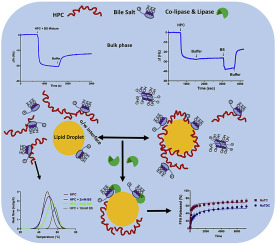当前位置:
X-MOL 学术
›
Food Hydrocoll.
›
论文详情
Our official English website, www.x-mol.net, welcomes your feedback! (Note: you will need to create a separate account there.)
Bulk and interfacial interactions between hydroxypropyl-cellulose and bile salts: Impact on the digestion of emulsified lipids
Food Hydrocolloids ( IF 10.7 ) Pub Date : 2020-09-01 , DOI: 10.1016/j.foodhyd.2020.105867 Jennifer Zornjak , Jianzhao Liu , Alan Esker , Tiantian Lin , Cristina Fernández-Fraguas
Food Hydrocolloids ( IF 10.7 ) Pub Date : 2020-09-01 , DOI: 10.1016/j.foodhyd.2020.105867 Jennifer Zornjak , Jianzhao Liu , Alan Esker , Tiantian Lin , Cristina Fernández-Fraguas

|
Abstract Hydroxypropyl-cellulose (HPC) is a surface-active, non-digestible polysaccharide, commonly used in food emulsions as thickener and/or emulsifier. Due to these dual characteristics, HPC is a potential ingredient to modulate lipid digestion. Since bile salts (BS) are key players during lipid digestion, the aim of this work was to investigate the impact that interactions of HPC with BS has on the digestion of emulsified lipids. We studied the effect of two BS species differing in bile-acid moiety, sodium-taurocholate (NaTC) and sodium-taurodeoxycholate (NaTDC). A Quartz-Crystal-Microbalance (QCM-D) was used to evaluate HPC-BS interfacial interactions during the sequential and simultaneous adsorption of both components at a hydrophobic surface, while micro-Differential-Scanning-Calorimetry was used to examine bulk interactions. In vitro lipid digestion was studied by using a pH-stat method. Results showed that, under fed-state conditions, NaTDC micelles were more effective at displacing a pre-adsorbed HPC layer from the surface than NaTC monomers. Nevertheless, HPC was resistant to complete displacement by both BS. Additionally, HPC was more susceptible to interact with NaTDC in the bulk, compared to NaTC, which made the adsorption more competitive for NaTDC. The reduced amount of free NaTDC in solution could explain the delayed lipolysis shown by HPC-stabilized emulsions when NaTDC was used to simulate duodenal conditions. These findings show that the delay of lipid digestion by HPC is due to the combined effect of HPC-BS interfacial and bulk interactions, with BS-binding in solution mostly contributing to this effect, and the BS molecular and micellar structure playing essential roles on both situations.
中文翻译:

羟丙基纤维素和胆汁盐之间的本体和界面相互作用:对乳化脂质消化的影响
摘要 羟丙基纤维素 (HPC) 是一种表面活性、不易消化的多糖,常用于食品乳液中作为增稠剂和/或乳化剂。由于这些双重特性,HPC 是调节脂质消化的潜在成分。由于胆汁盐 (BS) 是脂质消化过程中的关键因素,因此这项工作的目的是研究 HPC 与 BS 相互作用对乳化脂质消化的影响。我们研究了胆汁酸部分不同的两种 BS 物种、牛磺胆酸钠 (NaTC) 和牛磺脱氧胆酸钠 (NaTDC) 的影响。石英-晶体-微量天平 (QCM-D) 用于评估在疏水表面连续和同时吸附两种组分期间 HPC-BS 界面相互作用,而微差示扫描量热法用于检查本体相互作用。通过使用pH-stat方法研究了体外脂质消化。结果表明,在联邦状态条件下,NaTDC 胶束在从表面置换预吸附的 HPC 层方面比 NaTC 单体更有效。尽管如此,HPC 仍能抵抗两个 BS 的完全置换。此外,与 NaTC 相比,HPC 更容易与本体中的 NaTDC 相互作用,这使得吸附对 NaTDC 更具竞争力。当 NaTDC 用于模拟十二指肠条件时,溶液中游离 NaTDC 的量减少可以解释 HPC 稳定乳液显示的延迟脂肪分解。这些发现表明 HPC 延迟脂质消化是由于 HPC-BS 界面和本体相互作用的综合作用,溶液中的 BS 结合主要促成了这种效果,
更新日期:2020-09-01
中文翻译:

羟丙基纤维素和胆汁盐之间的本体和界面相互作用:对乳化脂质消化的影响
摘要 羟丙基纤维素 (HPC) 是一种表面活性、不易消化的多糖,常用于食品乳液中作为增稠剂和/或乳化剂。由于这些双重特性,HPC 是调节脂质消化的潜在成分。由于胆汁盐 (BS) 是脂质消化过程中的关键因素,因此这项工作的目的是研究 HPC 与 BS 相互作用对乳化脂质消化的影响。我们研究了胆汁酸部分不同的两种 BS 物种、牛磺胆酸钠 (NaTC) 和牛磺脱氧胆酸钠 (NaTDC) 的影响。石英-晶体-微量天平 (QCM-D) 用于评估在疏水表面连续和同时吸附两种组分期间 HPC-BS 界面相互作用,而微差示扫描量热法用于检查本体相互作用。通过使用pH-stat方法研究了体外脂质消化。结果表明,在联邦状态条件下,NaTDC 胶束在从表面置换预吸附的 HPC 层方面比 NaTC 单体更有效。尽管如此,HPC 仍能抵抗两个 BS 的完全置换。此外,与 NaTC 相比,HPC 更容易与本体中的 NaTDC 相互作用,这使得吸附对 NaTDC 更具竞争力。当 NaTDC 用于模拟十二指肠条件时,溶液中游离 NaTDC 的量减少可以解释 HPC 稳定乳液显示的延迟脂肪分解。这些发现表明 HPC 延迟脂质消化是由于 HPC-BS 界面和本体相互作用的综合作用,溶液中的 BS 结合主要促成了这种效果,



























 京公网安备 11010802027423号
京公网安备 11010802027423号